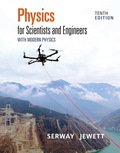
An unpolarized beam of light is incident on a stack of ideal polarizing filters. The axis of the first filter is perpendicular to the axis of the last filter in the stack. Find the fraction by which the transmitted beam’s intensity is reduced in the three following cases. (a) Three filters are in the stack, each with its transmission axis at 45.0° relative to the preceding filter. (b) Four filters are in the stack, each with its transmission axis at 30.0° relative to the preceding filter. (c) Seven filters are in the stack, each with its transmission axis at 15.0° relative to the preceding filter. (d) Comment on comparing the answers to parts (a), (b), and (c).
(a)
Answer to Problem 32P
Explanation of Solution
Given info: The number of the polarizing filters is
Here,
When an unpolarized light is passed through a polarizing filter intensity is reduced to half. So after passing through the first polarizer the intensity of the light becomes half.
Here,
The angle between the transmission axis of second polarizer and the first polarizer is
Here,
The third polarizing filter and the second polarizing filter has the same
Therefore the final intensity after three polarizing filters is,
Substitute
Substitute
From equation (5), a general formula for the calculation of intensity when light is passed through
Here,
Substitute
Therefore the absorbed intensity is
Conclusion:
Therefore, the fraction by which the intensity is reduced is
(b)
Answer to Problem 32P
Explanation of Solution
Given info: The number of filters are
From equation (6) the formula to calculate when there are
Substitute
Therefore the absorbed intensity is
Conclusion:
Therefore, The fraction by which the intensity is reduced is
(c)
Answer to Problem 32P
Explanation of Solution
Given info: The number of filters are
From equation (6) the formula to calculate when there are
Substitute
Therefore the absorbed intensity is
Conclusion:
Therefore, the fraction by which the intensity is reduced is
(d)
Answer to Problem 32P
Explanation of Solution
From equation (7), (8) and (9), it is evident that, as the number of polarizing filters increased the fraction of absorbed was decreased. For the case of
Conclusion:
Therefore, the intensity of light can be increased by increasing the number of stacks of polarizing filters by decreasing the angle between their transmission axis.
Want to see more full solutions like this?
Chapter 37 Solutions
EBK PHYSICS FOR SCIENTISTS AND ENGINEER
- pls help on all asked questions kindlyarrow_forward19. Mount Everest, Earth's highest mountain above sea level, has a peak of 8849 m above sea level. Assume that sea level defines the height of Earth's surface. (re = 6.38 × 106 m, ME = 5.98 × 1024 kg, G = 6.67 × 10 -11 Nm²/kg²) a. Calculate the strength of Earth's gravitational field at a point at the peak of Mount Everest. b. What is the ratio of the strength of Earth's gravitational field at a point 644416m below the surface of the Earth to a point at the top of Mount Everest? C. A tourist watching the sunrise on top of Mount Everest observes a satellite orbiting Earth at an altitude 3580 km above his position. Determine the speed of the satellite.arrow_forwardpls help on allarrow_forward
- pls help on allarrow_forward6. As the distance between two charges decreases, the magnitude of the electric potential energy of the two-charge system: a) Always increases b) Always decreases c) Increases if the charges have the same sign, decreases if they have the opposite signs d) Increases if the charges have the opposite sign, decreases if they have the same sign 7. To analyze the motion of an elastic collision between two charged particles we use conservation of & a) Energy, Velocity b) Momentum, Force c) Mass, Momentum d) Energy, Momentum e) Kinetic Energy, Potential Energyarrow_forwardpls help on all asked questions kindlyarrow_forward
- pls help on all asked questions kindlyarrow_forward17. Two charges, one of charge +2.5 × 10-5 C and the other of charge +3.7 × 10-6 C, are 25.0 cm apart. The +2.5 × 10−5 C charge is to the left of the +3.7 × 10−6 C charge. a. Draw a diagram showing the point charges and label a point Y that is 20.0 cm to the left of the +3.7 × 10-6 C charge, on the line connecting the charges. (Field lines do not need to be drawn.) b. Calculate the net electric field at point Y.arrow_forward3arrow_forward
 Principles of Physics: A Calculus-Based TextPhysicsISBN:9781133104261Author:Raymond A. Serway, John W. JewettPublisher:Cengage Learning
Principles of Physics: A Calculus-Based TextPhysicsISBN:9781133104261Author:Raymond A. Serway, John W. JewettPublisher:Cengage Learning Physics for Scientists and Engineers: Foundations...PhysicsISBN:9781133939146Author:Katz, Debora M.Publisher:Cengage Learning
Physics for Scientists and Engineers: Foundations...PhysicsISBN:9781133939146Author:Katz, Debora M.Publisher:Cengage Learning Physics for Scientists and EngineersPhysicsISBN:9781337553278Author:Raymond A. Serway, John W. JewettPublisher:Cengage Learning
Physics for Scientists and EngineersPhysicsISBN:9781337553278Author:Raymond A. Serway, John W. JewettPublisher:Cengage Learning Physics for Scientists and Engineers with Modern ...PhysicsISBN:9781337553292Author:Raymond A. Serway, John W. JewettPublisher:Cengage Learning
Physics for Scientists and Engineers with Modern ...PhysicsISBN:9781337553292Author:Raymond A. Serway, John W. JewettPublisher:Cengage Learning
 Physics for Scientists and Engineers, Technology ...PhysicsISBN:9781305116399Author:Raymond A. Serway, John W. JewettPublisher:Cengage Learning
Physics for Scientists and Engineers, Technology ...PhysicsISBN:9781305116399Author:Raymond A. Serway, John W. JewettPublisher:Cengage Learning





